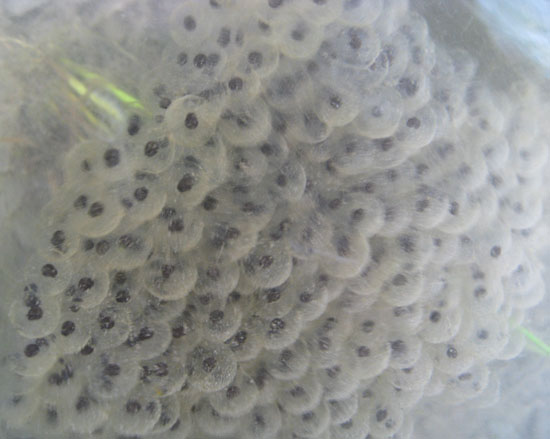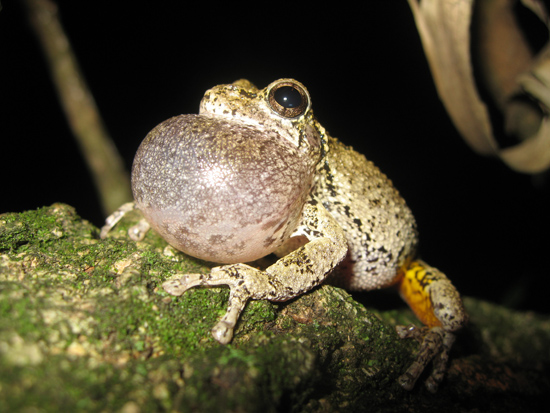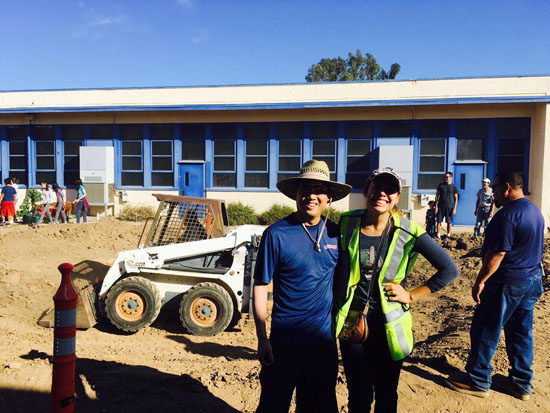The California Red-Legged Frog Habitat Expansion Project
Enjoy this page all about our Tahoe Wetlands project, featuring writing by a variety of people involved in the project.
Project Summary By SAVE THE FROGS! Volunteer Logan Rance
The Sierra Nevada mountain range of eastern California is home to some of the most diverse ecosystems in the world. From sprawling mountain forests to high alpine meadows, the Sierra Nevadas are ecological hotspots and home to eight national forests. Despite its ecological diversity, this region is increasingly threatened by a variety of issues including deforestation, grazing, pollution, and mining.
One of the species most impacted by these threats is the California Red-Legged Frog (Rana draytonii). Aptly named for its red hind legs, the California Red-Legged Frog is most commonly found in California’s Coast Ranges, as well as in isolated patches of the Sierra Nevada foothills. As the state amphibian of California, the species is quite charismatic– it’s the largest frog in the western United States, and it was even the star of Mark Twain’s 1865 short story, “The Celebrated Jumping Frog of Calaveras County.” Unfortunately, due to habitat loss, pollution, and predation by non-native species, California Red-Legged Frog populations are in decline. It’s estimated that this frog has lost up to 75% of its native range, and as a result, it’s currently recognized as a federally threatened species.
However, a dedicated team of biologists and frog-loving volunteers have been working to change this. Throughout several weeks in April and May 2021, over 100 volunteers, scientists, and national parks staff converged from across the country in Tahoe National Forest to build new wetland habitats for the California Red-Legged Frog. This team included volunteers from 12 different organizations, including several from SAVE THE FROGS!. One STF! volunteer travelled over two-thousand miles to participate in this exciting project. At its conclusion, this collaborative effort resulted in the creation of 18 new wetlands that ranged in size from 30’ x 30’ to 80’ x 100’.
Dan Teater, a biologist with the U.S. Forest Service, was an instrumental player in this project’s success. Dan explained that when it came to creating these wetlands, there was more to the process than meets the eye. “When you go out there, it looks like 18 holes in the ground. But what you don’t see is the level of detail, measurement, and planning that went into creating them. It’s an amazing amount of work, and I was stunned at the physicality of this project. It would not have been possible without our volunteers.”
While the wetlands have been successfully created, the project isn’t over– it will take some time for frogs to populate this new habitat. “The story of these wetlands’ success is going to be told over the coming years,” Dan explained. “It’s going to depend on what kind of water years we have. In the future, we may even explore opportunities for translocation and moving egg masses from wetlands nearby.” While the ultimate goal of this project is to provide new amphibian habitat and support conservation efforts, it will also create great new opportunities for amphibian education, outreach, and research. Dan says that down the road he envisions consultants and biologists using these sites for conservation trainings, and even hopes to incorporate high school educational programs into the project.
This effort would not have been possible without the work and dedication of the many volunteers who contributed to this project. Dan anticipates that there will be more projects like this to come, and that volunteers from SAVE THE FROGS! and other like-minded organizations will play a crucial role in their success. When asked if there was more wetland creation on the horizon, Dan concluded by quoting a wetland engineer who assisted with the Tahoe project: “Is there such a thing as building too many wetlands? Can you have too many? That’s like saying my vehicle gets too many miles per gallon, or that my partner is too attractive. When you look at all they do for the environment, it just can’t be done.”
“I heard from Logan and we conducted a fun and brief interview. She was great to talk with.”
— Dan Teater, Project Lead, USFS
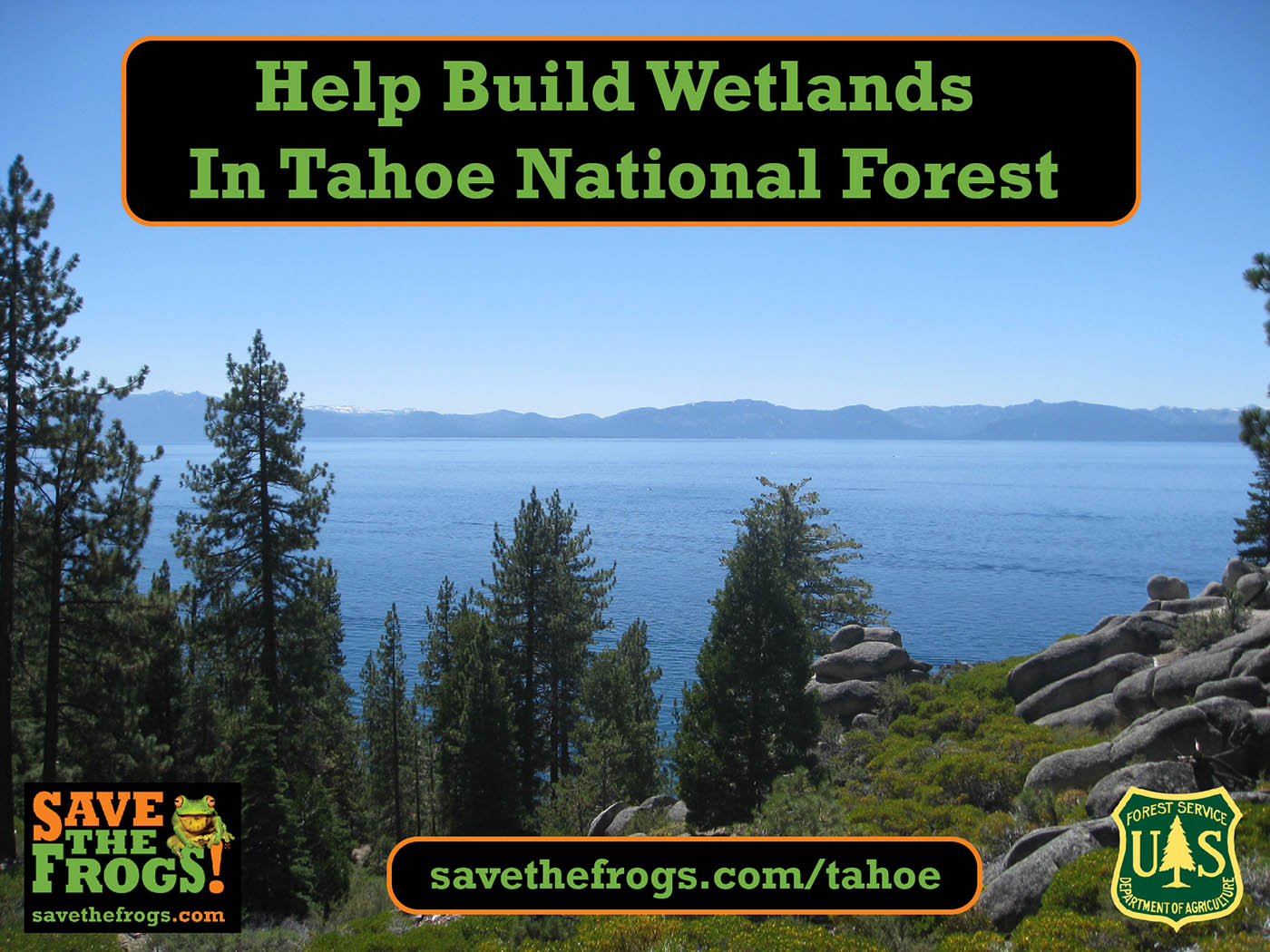
This Tahoe Wetlands page is where we announced the event in search of volunteers, with help from the image above.
Project Report From Dan Teater of the US Forest Service
On the American River Ranger District, construction has been completed on 18 wetlands for the endangered California Red-Legged Frogs. The United States Fish and Wildlife Service recognized this project as the largest conservation effort to date in the Sierra Nevadas for the California Red-Legged Frogs.
This was a partnership project between the United States Forest Service, Nevada and Placer County, United States Fish and Wildlife Service and the Sheltowee Environmental Education Coalition. The project was funded by Nevada and Placer Counties Resource Advisory Committee as well as the United States Fish and Wildlife Service, and is located in the community of Michigan Bluff and borders the area of Big Gun Diggins.
The project was made possible by nearly 100 volunteers and agency staff who contributed more than three days each to the project. Volunteers from across the country included the following states, Colorado, Kentucky, Arizona, Nevada, California and New York. The Longest Traveler Award goes to SAVE THE FROGS! Volunteer Federica “Freddie” M., who traveled approximately 2,500 miles from New York to help build wetlands for the California red-legged frog. Volunteers represented organizations from the American Conservation Experience, Great Basin Institute, South Yuba River Citizens League, Trout Unlimited, SAVE THE FROGS!, Rio Grand Return, Bat Conservation International, Barceloux-Tibessart Foundation, Sequoia Ecological and AmeriCorps.
This was a meaningful effort to train agency and non-profits on how to build wetlands for listed species. The Inyo, Eldorado and Tahoe National Forests provided staff to participate in this effort. Yosemite National Park Service also encouraged and allowed staff to participate in this unique opportunity.
The California Red-Legged Frog Habitat Expansion Project would not have been possible without Tom Biebighauser, Don Smith and all of the volunteers who participated. It was one of my career highlights to work with Tom Biebighauser who is a world renowned expert in building wetlands for listed species. It was an honor to work with our heavy equipment operator Don Smith because there is no way we could have accomplished all of this work in the timeframe we did without his unique talent. I cannot thank all of the volunteers enough for their commitment to the project and the extraordinary contribution to resources on the Tahoe National Forest. This story will continue to unfold for years to come, so stay tuned and reach out.
“I am excited to reveal that our wetlands are full of water and are currently under many feet of snow. On my last visit to the wetlands in November, the wetlands were at full pool and looking really “froggy”. We deployed some native seed to get some ground cover established and reduce sedimentation into the wetlands. We want to maintain max depth at these wetlands to ensure suitable breeding habitat.”
— Dan Teater, January 2022
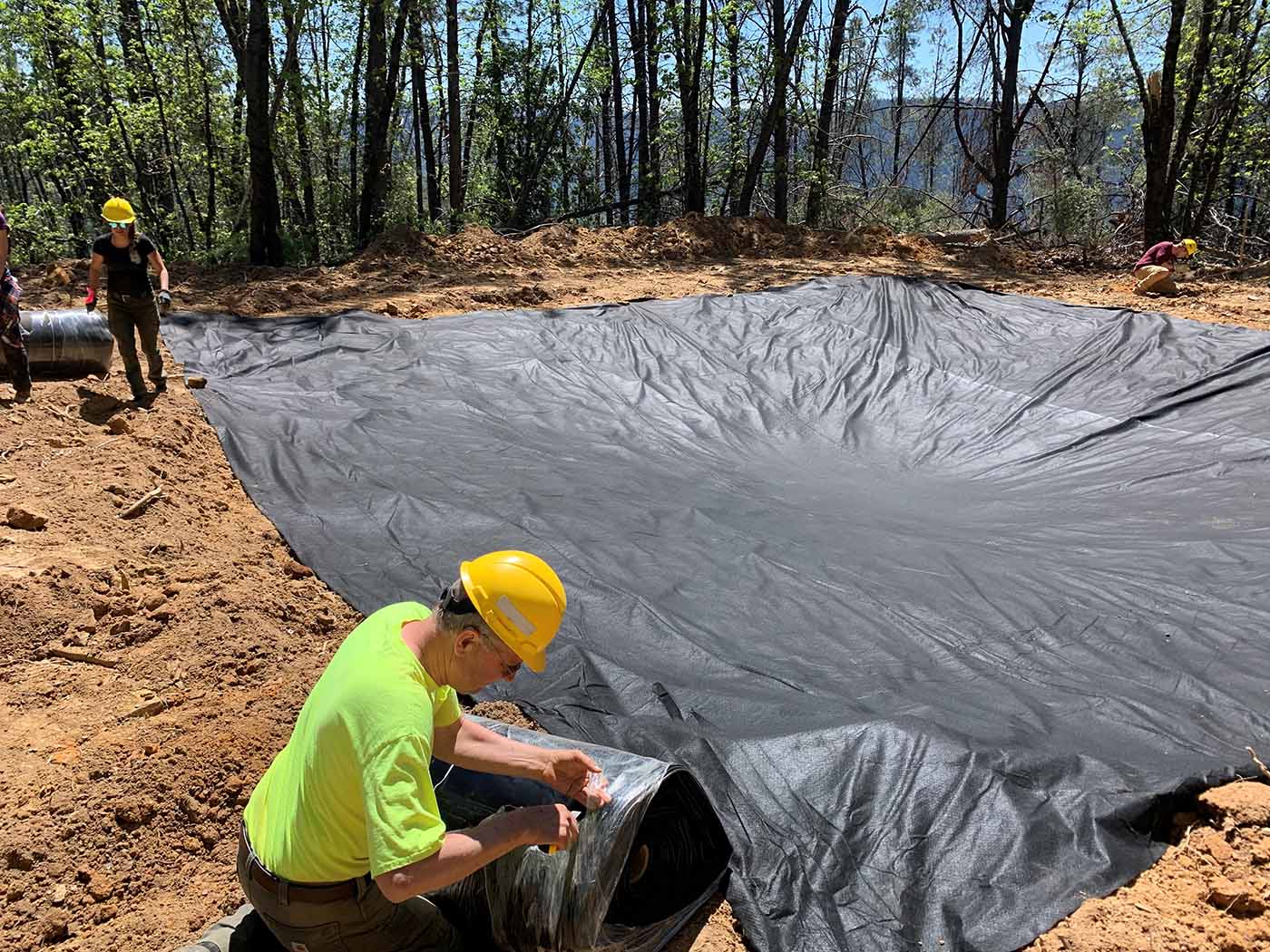
Above is a photo of the fish-safe liner being installed on Wetland 11. Below is a photo of the wetland about six months later, in late 2021.
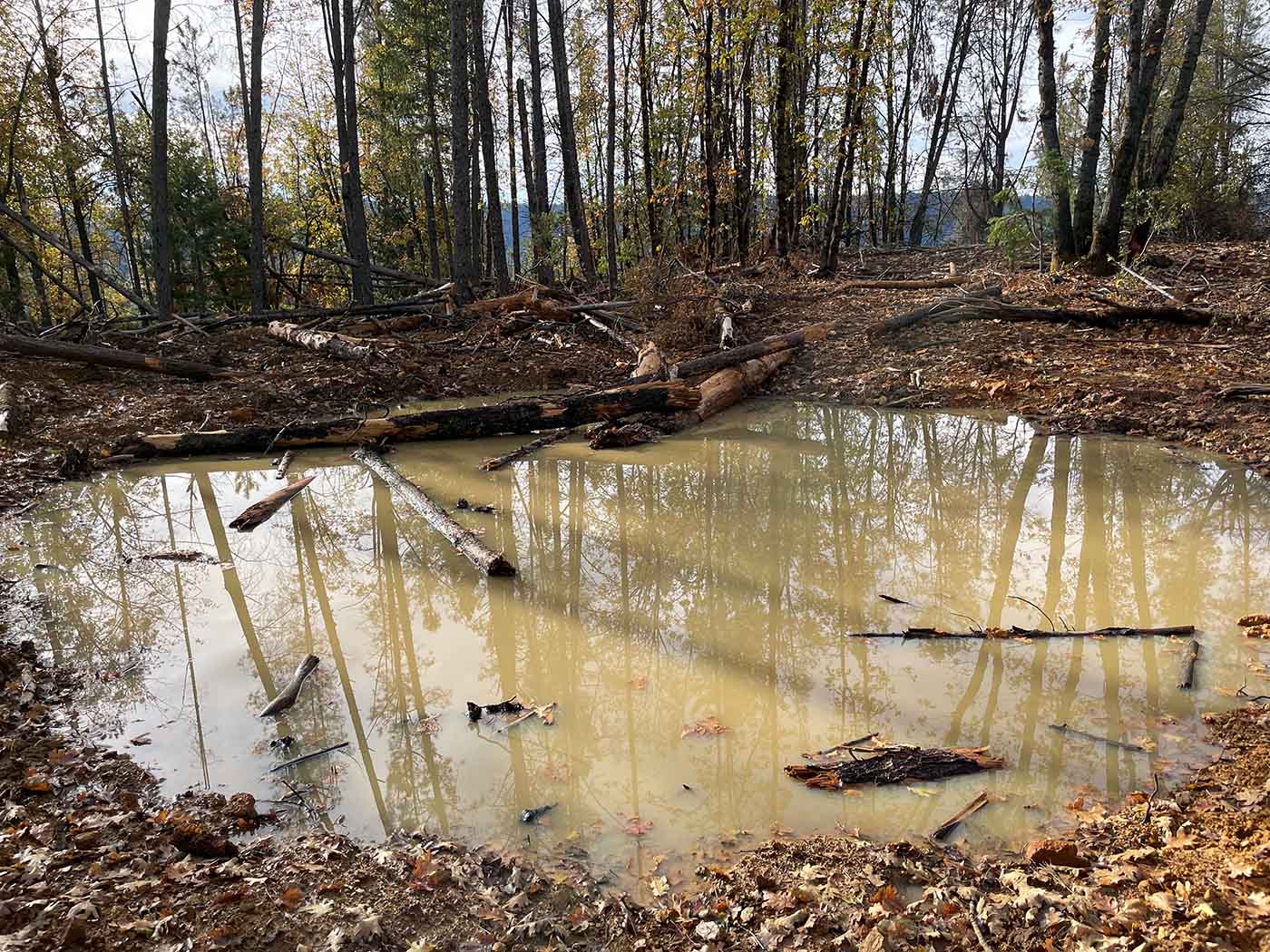
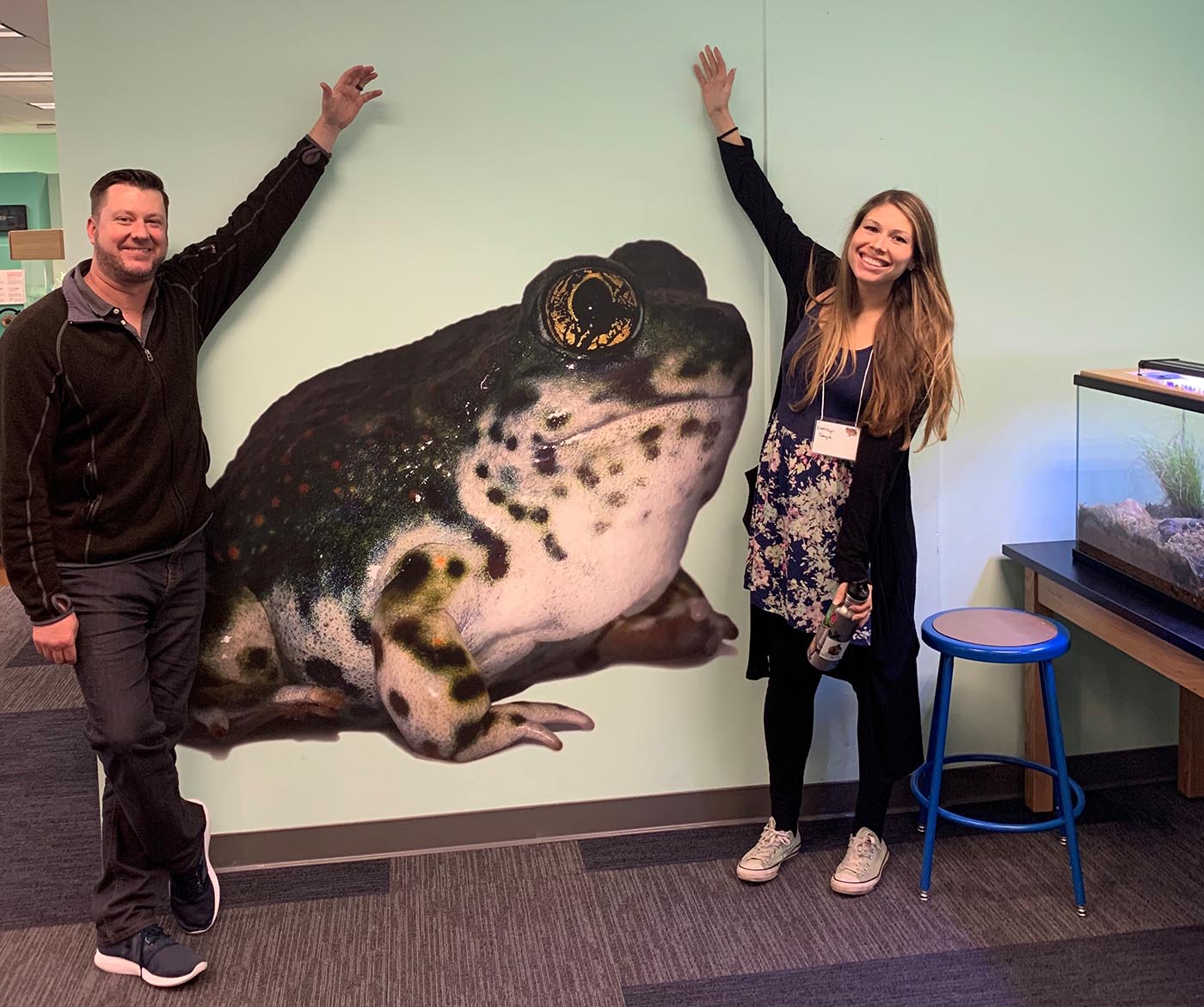
Dan Teater of the USFS and Kathlyn Franco Osagie (who has helped build many SAVE THE FROGS! wetlands), along with a spadefoot at the APTF meeting in 2020.
Feedback From Project Participants
Amy Lind, Hydroelectric Coordinator, US Forest Service
Dan – What a phenomenal effort – big congratulations! It is hard to appreciate the scope of the project, until you see it person. On my brief visit near the end of construction, Dan, though exhausted from 3 weeks of being on site and on point every day, continued to express enthusiasm, knowledge, and optimism for the long-term benefits of this project. My favorite moment that day was standing at the edge of a newly constructed basin – Dan pointed across a narrow valley to the existing mitigation site (near Michigan Bluff) where there is a current population of California red-legged frogs. I started to visualize frogs hopping from that site to the basin we were standing next to, and I felt very hopeful.
I highly recommend a visit to this project with Dan, who has become an expert on California red-legged frogs and wetland construction.
Thanks for this great work!
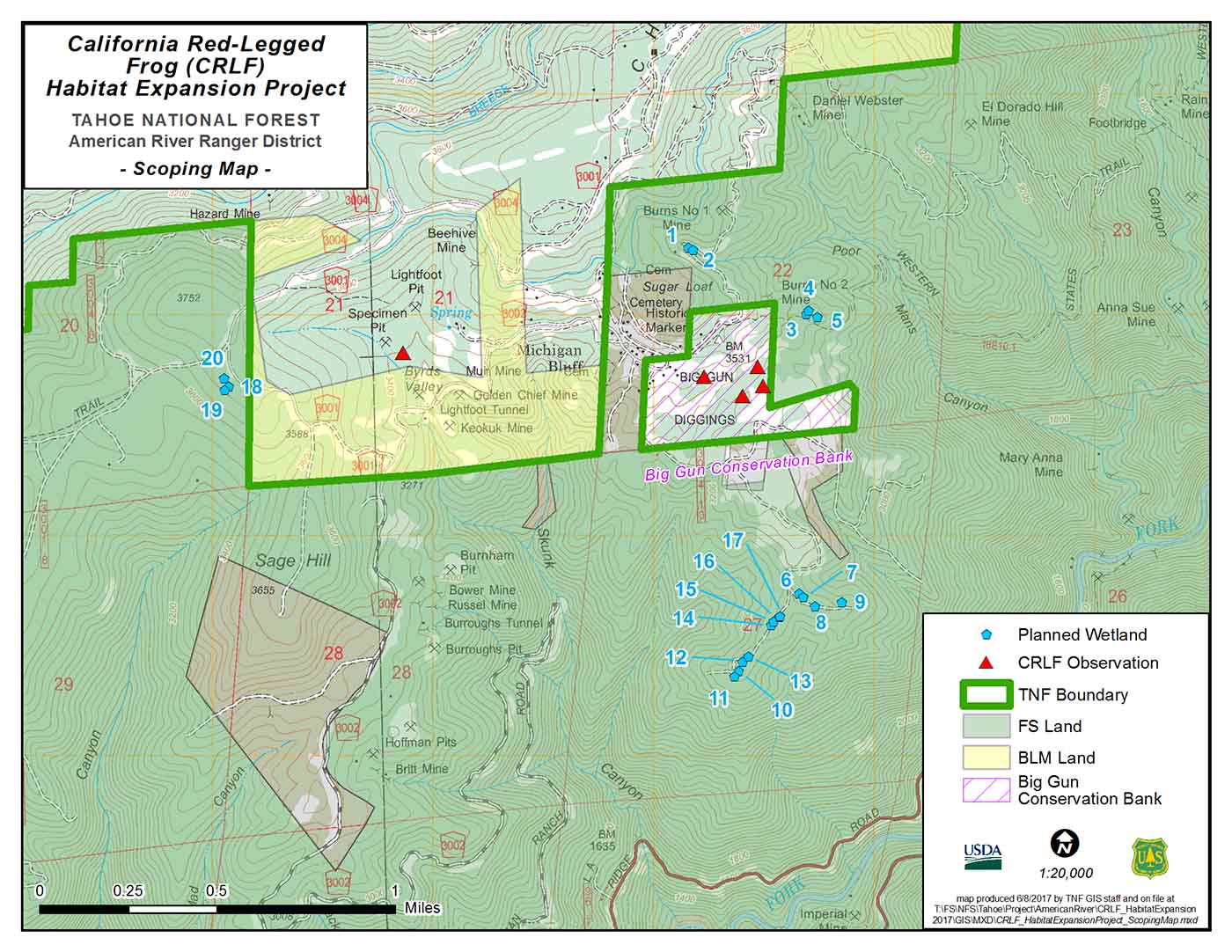
Project scoping map
Karl Ronning, Hydrologist, South Yuba River Citizens League
Second everything Amy said! Thank you Dan for all your hard work in bringing this project to fruition. Your passion and determination to help these frogs was infectious and inspired me to keep hucking rocks all day. Also I attached my favorite photo of our young frog experts searching for CRLF at the BLM wetlands. 😊

Action photo by Karl Ronning
Event Report from SAVE THE FROGS! Volunteer Freddie M.
Dear Kerry,
I had a great time in Tahoe National Forest helping to build wetlands for the endangered California red legged frog. This was my first time visiting the Sierra Nevada mountains. My parents had vacationed in Lake Tahoe shortly after I was born and I grew up in NYC looking at photographs of Lake Tahoe. I always wanted to visit, so when I read about this project in your newsletter, I immediately decided to volunteer.
On May 2, I flew from NYC to Sacramento, rented a car and drove to the Holiday Inn in Auburn. The next morning, I met Dan Teater at 8 a.m. at the ranger station. What a great guy! That was my routine for the next three days. Dan drove me to the staging area and I met the crew working that day. Every day the crew changed as people came and went.
My first day we worked on ponds #13, 14 and 15. The day I arrived, the Don, driving the excavator, had already cleared the land and created three carefully measured, shallow depressions, 40 feet across (if I’m remembering correctly). We spent most of the day removing rocks and boulders from these 3 areas, checking elevation, unwrapping and positioning 3 different rolls of plastic sheets that would serve as an impervious pond liner that could last for hundreds of years. After the third plastic liner was placed on top, the volunteers drove metal stakes into the three liners all along the perimeter to hold it in place, and extra plastic was carefully trimmed. We then watched Don expertly maneuver the Excavator to cover the liners with six inches of dirt. The volunteers then “furnished” the ponds by dragging in logs and branches at various levels to create frog and tadpole habitats. We even learned how to make “frog condominiums” using three flat stones.
As you know, Tom B is a natural teacher and loves to share his knowledge. Don, who drove the excavator, was masterful behind the wheel and made everything look easy. Although I was hot and tired by the end of the day, I managed to find an excellent vegan restaurant not far from my hotel.
The second day was physically easier. Dan gave us a driving tour of the completed ponds and drove us through the town of Michigan Bluff. Dan explained that there were red-legged frogs living on private property in Michigan Bluff, which was the center of the gold rush in the 1880s. Dan hoped that the existing frogs would migrate to the 18 man made ephemeral ponds that would fill with water every spring. We added roots and logs to some of the ponds already finished. We watched Don decommission a road with the Excavator. In the afternoon, Dan gave us a tour of 2 ponds managed by the Bureau of Land Management that were created 4 years ago. I was thrilled to see that, despite the drought, both ponds contained water and tadpoles.
I spent my third day with other volunteers scoping out the last location for 2-3 ponds. Dan and Tom expected that this area would have enough clay in the soil to contain and trap the water in the spring without having to add a plastic liner. Fortunately, after testing the soil, there did seem to be enough clay to complete the project as planned. These ponds were completed after I left on May 6.
Although I worked for only three days, time slowed down and it seemed like I was away for a few weeks. I hope that the California red-legged frogs will thrive there and I look forward to following this project in the future.
Regards, Frederica M.
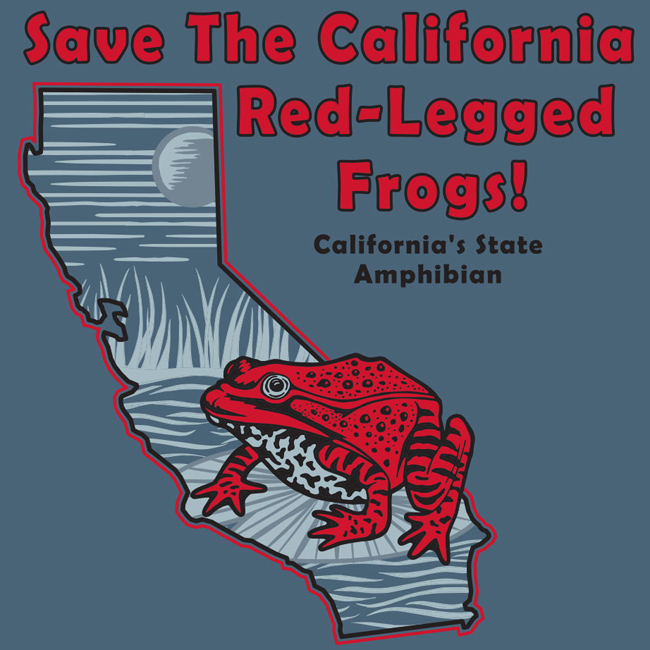
We hope you can help us save California’s State Amphibian at upcoming wetland events! Did you know … SAVE THE FROGS! successfully campaigned for the frog’s state amphibian listing in 2014, resulting in Governor Jerry Brown signing AB2364.
April 2023 Update From Dan Teater
Greetings From California,
It comes with mixed emotion to inform you that our newly constructed CRLF wetlands were directly impacted by the Mosquito Fire in the fall of 2022. Below you will find my Burned Area Emergency Response report that speaks to the potential impacts from the fire.
On a more positive front, I am happy to announce that this extremely wet water year has these wetlands brimmed with water. The clay lined wetlands are also holding water and functioning, which is a great sign. The geotextile fabrics and aquatic safe liners all seem to still be intact even after this catastrophic fire. Anything less that 6” of top soil on top of the liners may have resulted in a much different story. Unfortunately many of the large woody materials and created log jams were consumed by the fire which you will see in the attached reports and pictures. However, I am working on multiple fronts to get that woody material replaced so these frogs can have a place to bask and attach egg masses on.
I recently hiked into wetlands 3,4 and 5 and was stunned to hear the ROAR of sierran tree frog chorus! WAHOOOO! I am hoping this proves to be an important vocal attraction for our target species, the California red-legged frog.
This week I observed all life stages of sierran tree frogs at all of the newly constructed wetlands. Please pass this along to Freddy and Chris, I know they will be excited to learn that the wetlands are now occupied by amphibians. It will just be a matter of time before the California red-legged frogs will be occupying these wetlands
I hope that you and the crew are cranking out some amazing wetlands in Illinois. I am soooo jealous, wishing I was there with you all. The YouTube video that you all created really tells the story. Proud of you all! Cheers and feel free to reach out anytime.
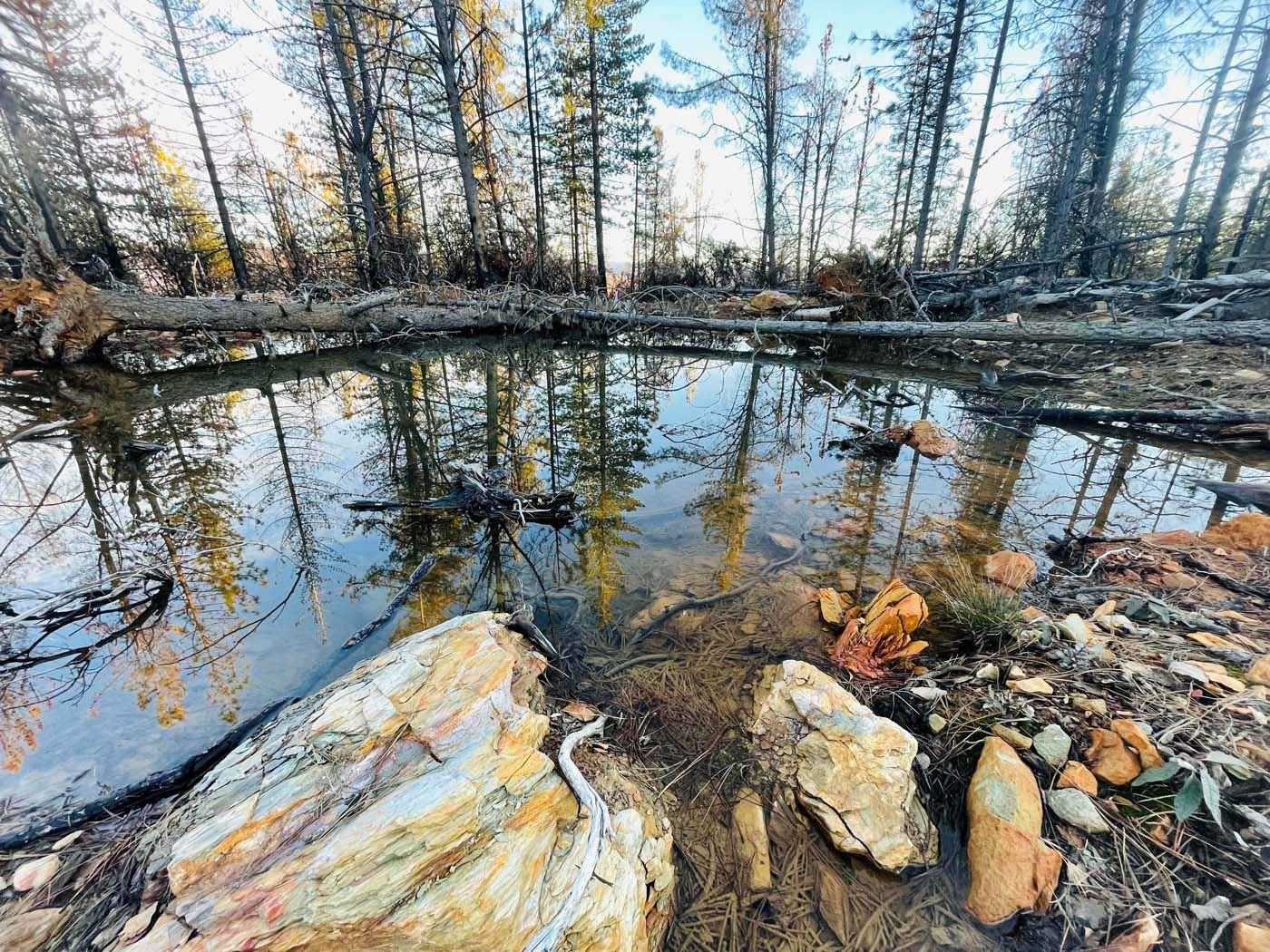
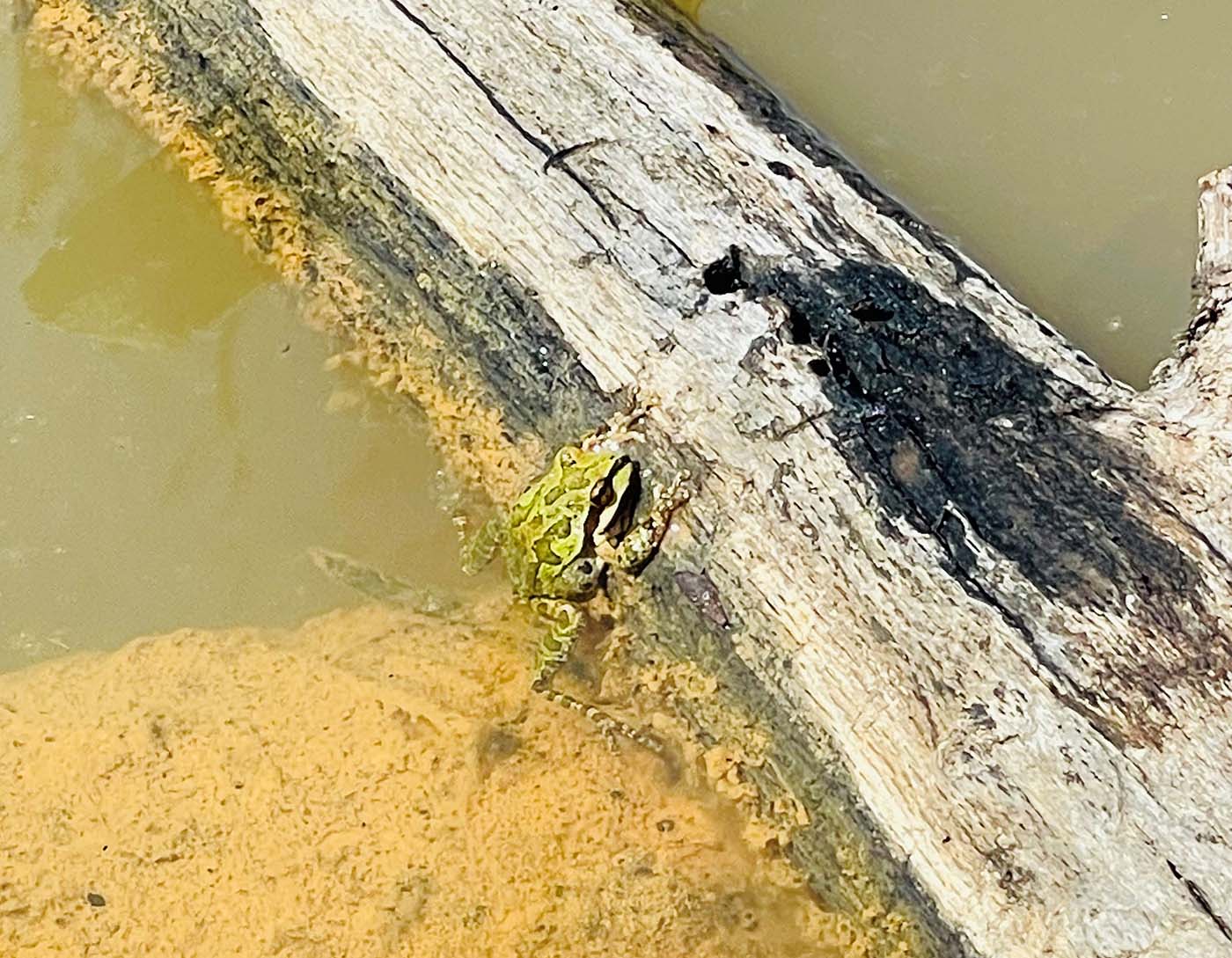

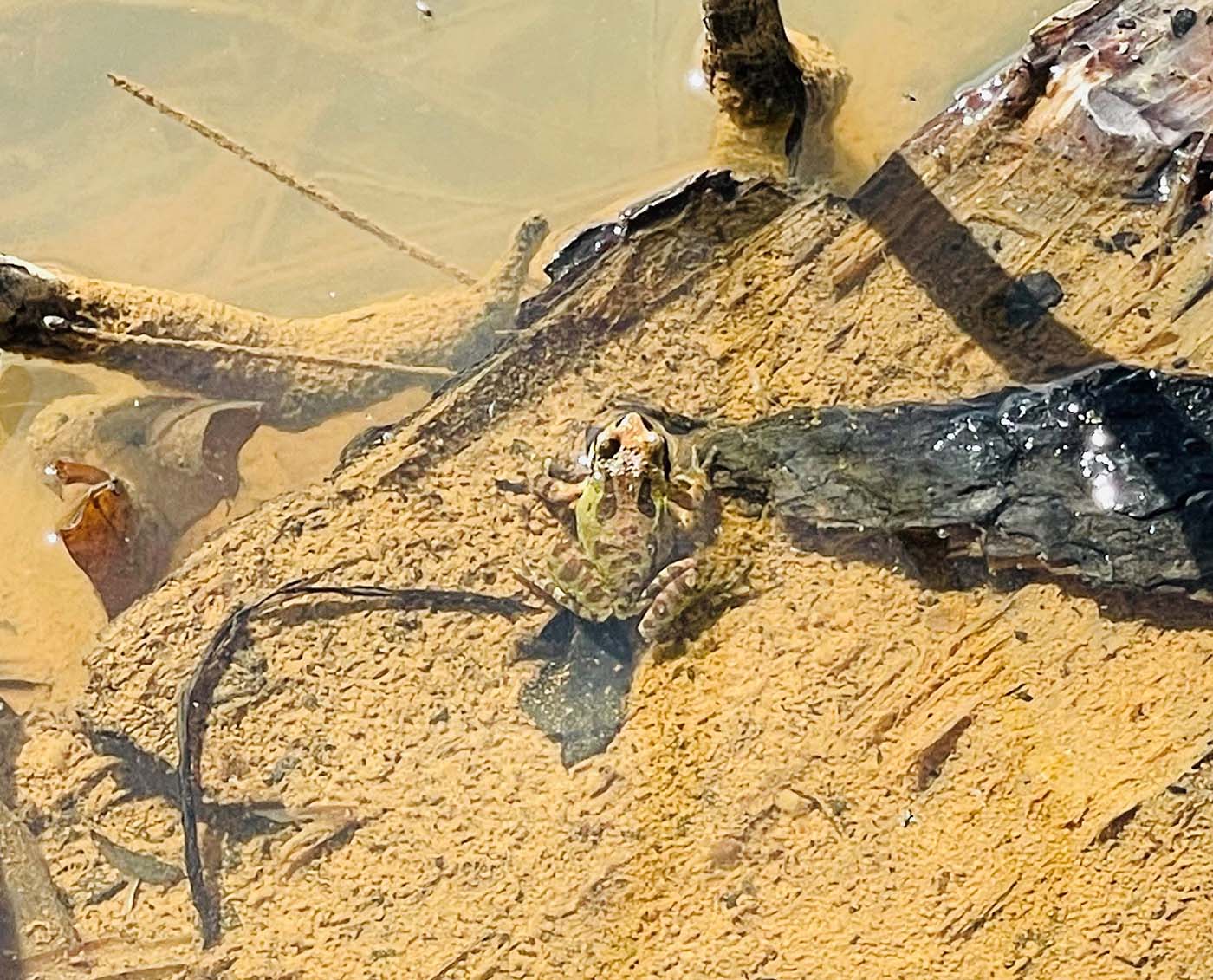

Burned Area Emergency Response Report
You can download or scroll through this 17 page PDF.
Tahoe-Wetlands-2022-Aquatics-Burned-Area-Specialist-ReportPress Release from the US Forest Service
California-Red-Legged-Frog-Habitat-Expansion-Project“I’m a big fan of the organization! I was one of the volunteers for the wetland construction project for the Red-Legged Frog in Tahoe last year and it was such a great experience. I’m definitely planning on volunteering with you guys again at some point. Thanks for the awesome opportunity!”
— Chris Schwartz, SAVE THE FROGS! Art Contest Participant and Wetland Volunteer
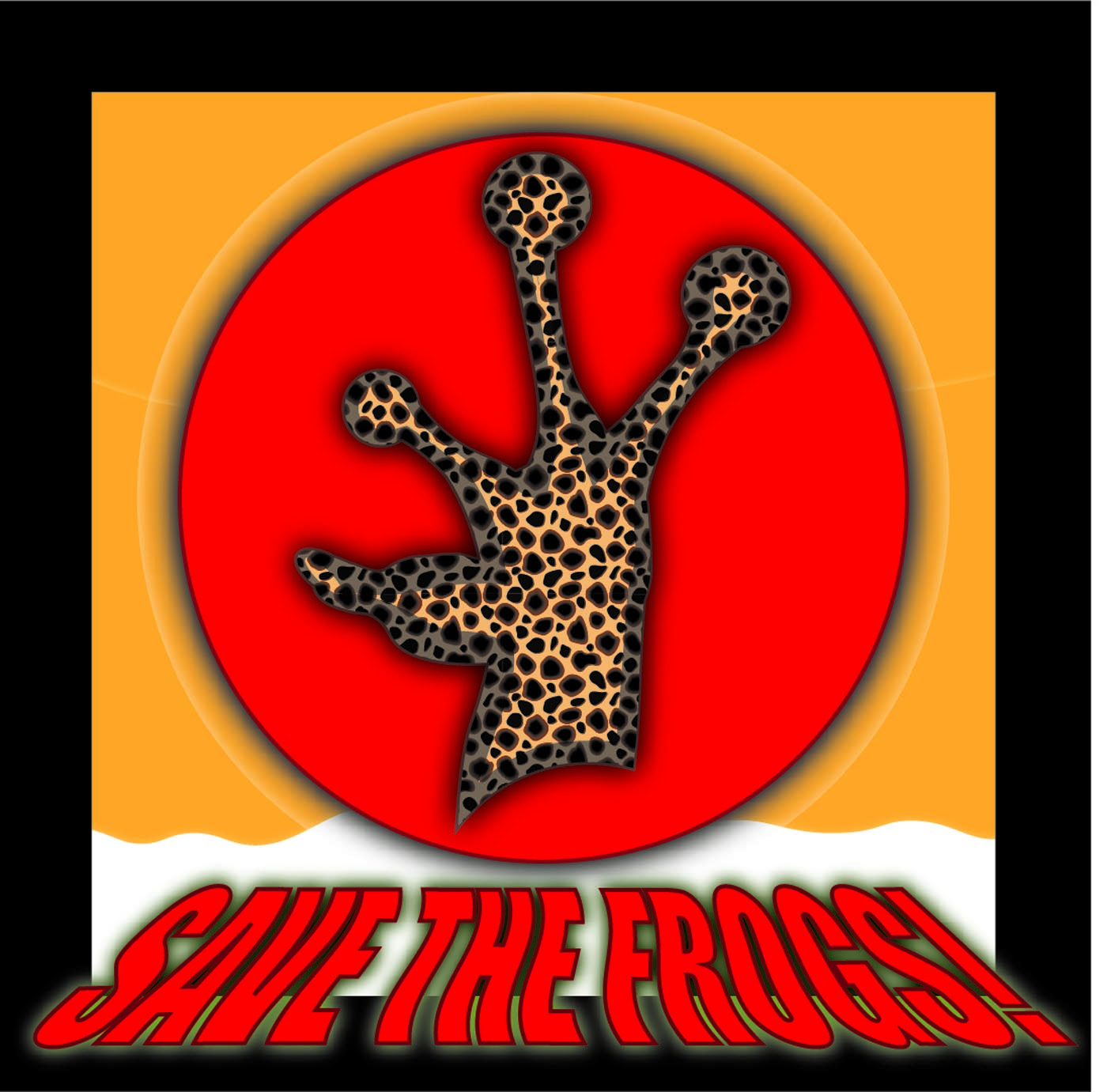
Amphibious art by Chris Schwartz of the USA, 2021 SAVE THE FROGS! Art Contest Honorable Mention
Tahoe Project Proposal
Learn more about this project and how it came to be in the December 19, 2019 report below, prepared by Tom Biebighauser, who also led the 2016 wetland construction events at Eldorado National Forest and the 2017 events at Plumas National Forest.
Tahoe-Wetlands-California-Red-legged-Frog-Habitat-Expansion-Project-Report-2019-12-19Tom Biebighauser and Kathlyn Franco Osagie
Wetland Restoration And Construction: A Technical Guide
Tom Biebighauser created this amazing book to help people like you build wetlands.
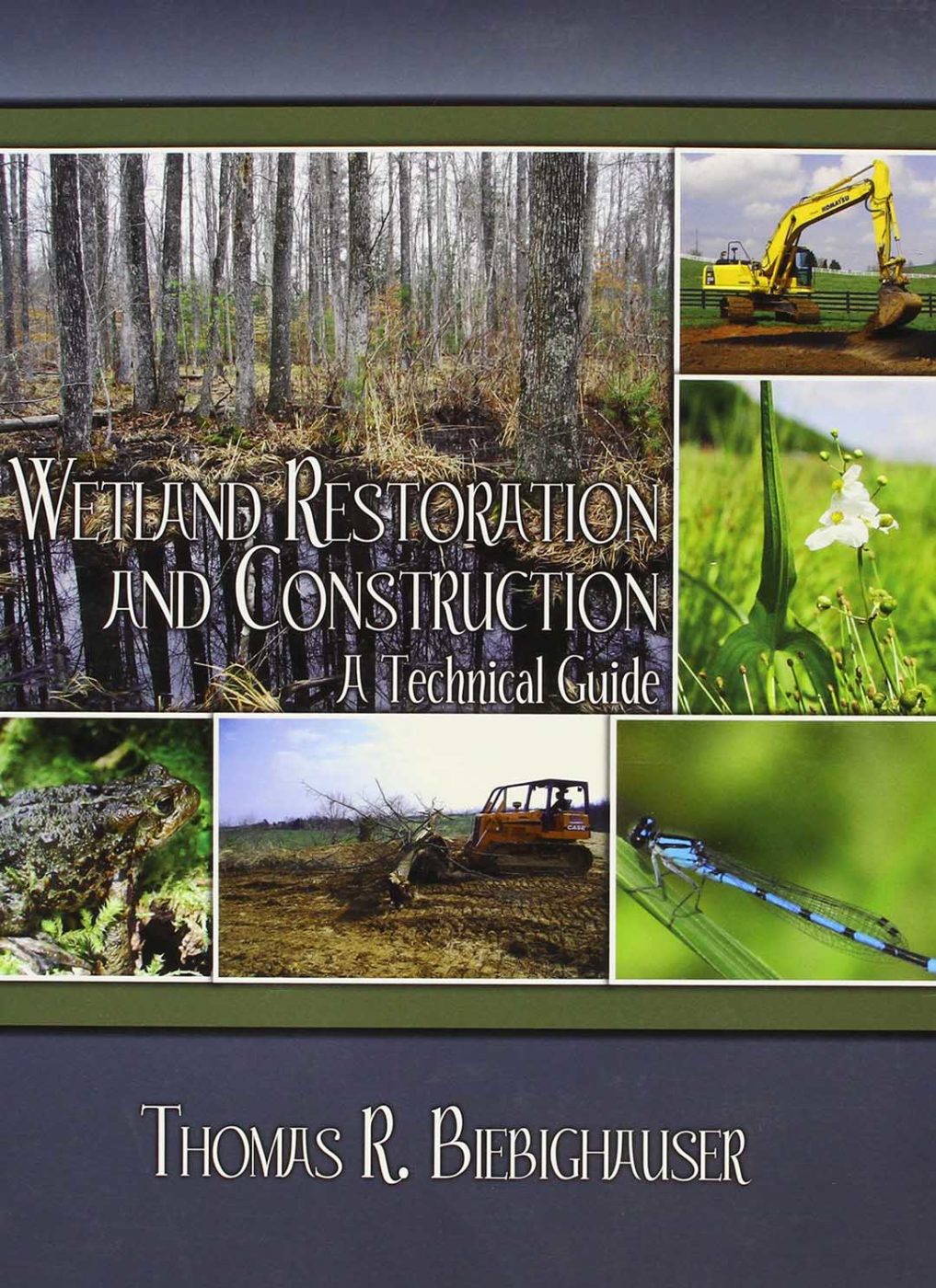
Enjoy the book!
Questions?
Please direct any questions to:
Dan Teater
Tahoe National Forest, American River Ranger District
22830 Foresthill Road Foresthill, CA 95631
dan.teater@usda.gov
p: 530-367-2224 x270
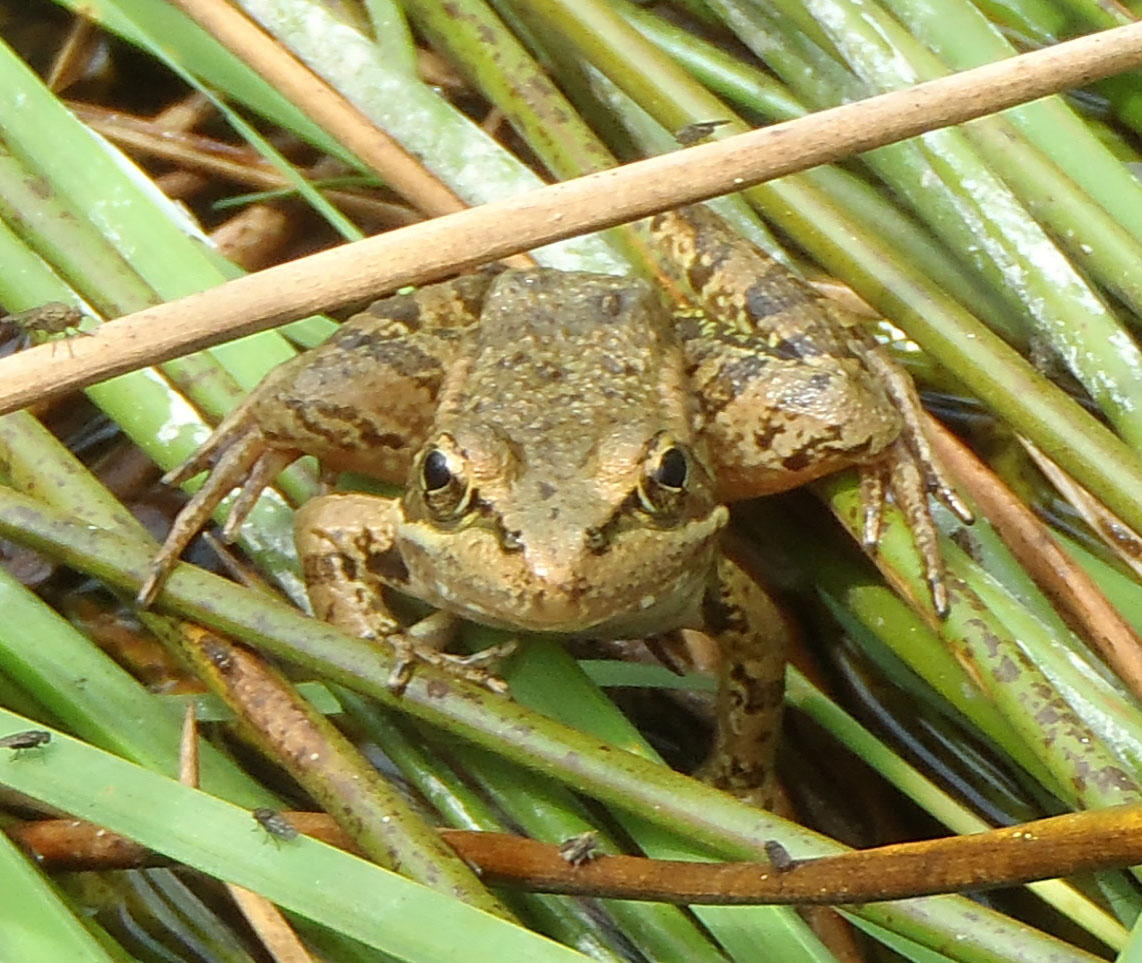
California Red-legged Frog (Rana draytonii) photo courtesy Chris Berry, City of Santa Cruz





